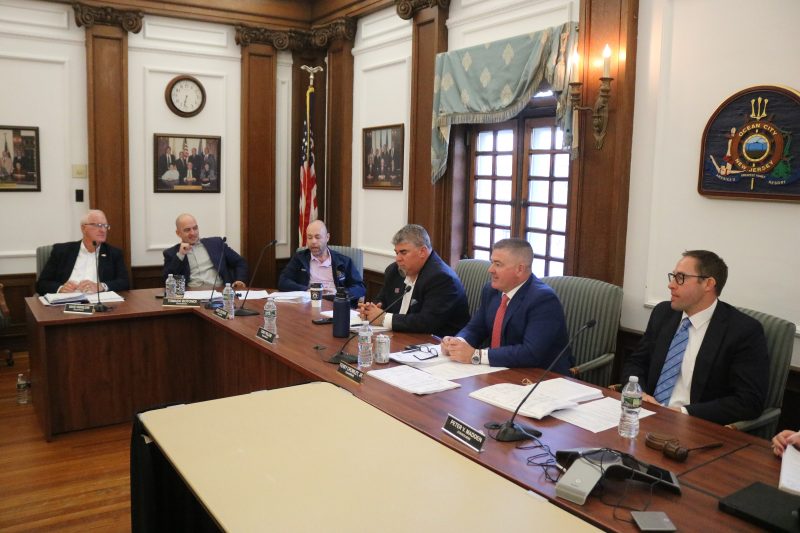By DONALD WITTKOWSKI
Ocean City is kicking in an extra $850,000 to pay for the rising cost of cleaning up contaminated soil from property that it acquired through eminent domain and plans to preserve as open space.
However, city officials stressed that Ocean City will receive credit for the environmental cleanup costs from the property’s previous owner, Palmer Center LLC, once the work is finished and a final price is determined for the land.
“Just to reiterate, the previous owner is responsible for the actual cleanup,” Councilman Tom Rotondi said.
City Council introduced an ordinance Thursday night to authorize the extra $850,000 in funding for the ongoing cleanup work of the property at 16th Street and Haven Avenue and 109 16th Street. A public hearing and final vote on the ordinance are scheduled for the March 28 Council meeting.
City Solicitor Dorothy McCrosson told Council that more money is needed for the environmental remediation work primarily because of the rising cost of disposing of the contaminated soil at a facility that can properly handle it.
For months, a city contractor has been removing contaminated soil believed to stem from a former dry-cleaning business on the Palmer Center property.
In 2021, the city used its power of eminent domain to acquire the Palmer Center land after it could not reach an agreement with the group on a final price. Palmer Center is headed by developer and former City Councilman John Flood, who ran unsuccessfully for mayor in the 2018 election against Mayor Jay Gillian.
The city offered to pay Palmer Center $5.6 million for the land, but both sides are still in court fighting over the final price. City Council went into closed session Thursday night to discuss the litigation, but declined to comment because the legal battle continues.
On top of the $5.6 million to purchase the land, the city also previously set aside $1.55 million to pay for environmental cleanup. Now comes the extra $850,000 over and above the $1.55 million to cover rising costs for cleanup work.
“It’s going to be more costly to remove the materials in the soil in a manner that’s prescribed by law,” said Frank Donato, the city’s chief financial officer.

City Council introduces an ordinance authorizing $850,000 to help pay for the cleanup work.
City officials have repeatedly said Ocean City will seek repayment of the cleanup costs from Palmer Center after the remediation is completed and a final purchase price for the land is decided.
“From the funds already paid into court for the purchase of that property, a little more than $1.5 million was held back to reimburse the city for its remediation efforts. There will be separate action to recover those costs from the owner of the property,” McCrosson told Council at Thursday’s meeting.
The Palmer Center property is among three sites the city has acquired through eminent domain to create a full block of land bordered by Haven and Simpson avenues between 16th and 17th streets next to the Ocean City Community Center.
The land will be added to a corridor of open space protected from dense housing construction. The city plans to dedicate a five-block area from 15th Street to 20th Street to open space and public use.
Recently, the city finally wrapped up a lengthy legal battle with the private owners of property adjacent to the Community Center by agreeing to pay $20 million for their land.
Using its power of eminent domain, the city acquired the land in 2021 from Klause Enterprises to preserve it as open space after brothers Jerry and Harry Klause proposed to develop the site for housing construction.
The city originally sought to buy the land for $9 million. However, the case went to court over the value of the land. Last October, a jury decided that the city should pay Klause Enterprises nearly $17.9 million for the property.
Interest payments on top of the nearly $17.9 million pushed the total amount to $20 million.
The property was best known as the former site of the Perry-Egan auto dealership. The city’s main objective in acquiring the land was to stop the site from being densely developed. At one point, the Klause brothers proposed building 22 single-family homes on the land.

Rows of pipes, pictured in December, are stacked on the property for the environmental cleanup work.

Paid for by Michael DeVlieger

 Rows of pipes, pictured in December, are stacked on the property for the environmental cleanup work.
Rows of pipes, pictured in December, are stacked on the property for the environmental cleanup work.
 Paid for by Michael DeVlieger
Paid for by Michael DeVlieger